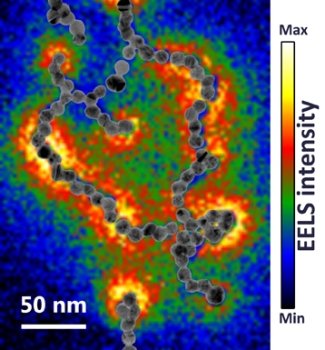Gold nanoparticles fused into long chains have been used to confine light, effectively making a nanoscale optical fiber that could be used in computing and communications.

The research was conducted by researchers from Singapore and Bristol in association with the Centre d'Elaboration de Matériaux et d'Etudes Structurales (CEMES, CNRS), and was published in Nature Materials.
Information can be transmitted using light - as in fibre optic broadband connections. This property could also be used to develop an incredibly high-speed alternative to microelectronics.
Unlike electric signals, using light to carry data minimizes the energy loss through heating, while increasing the transmission rates. However, there are several issues in the way of "photonic" circuits reaching the level of capabilities we currently have with electronics - primarily the issue of miniaturization. Fiber optics work well, but only at scales well above the micro- or nanometer dimensions that electronics work on.
One promising way of creating sufficiently small channels to carry light is plasmonics. Developed over the last two decades, plasmonics makes use of the fact that electrons sometimes oscillate on the surface of a metal in the presence of light, rather than moving freely. These surface vibrations, called plasmons, can be used to trap light energy.
 EELS image showing the spatial distribution of electrons confined along a chain of gold nanoparticles. © E. Dujardin (CEMES, CNRS)
EELS image showing the spatial distribution of electrons confined along a chain of gold nanoparticles. © E. Dujardin (CEMES, CNRS)
The research findings showed that the plasmons on 10nm diameter gold nanoparticles produce specific oscillations conducive to highly confined propagation, when the nanoparticles are aligned in a chain. The energy, however, disappeared when it passed between two nanoparticles, making this characteristic unsuitable for long-range propagation. This property can be applied to certain applications, which involve highly localized heat sources such as medicine.
The research team, using a high-energy electron beam, combined the nano-beads to form a continuous crystalline network. This reduced the energy loss, allowing the plasmons to oscillate freely over long distances, whilst still remaining confined within the nanoparticles' diameter. The information can travel to up to 4000nm within this 10nm-wide string of particles.
This research could result in further miniaturization of light guidance and open a new platform for telecommunication and sensor applications.
Read the full paper in Nature Materials: Multimodal plasmonics in fused colloidal networks